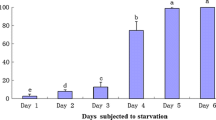Abstract
Requirement for dietary n−3 HUFA (n−3 highly unsaturated fatty acid) for growth and survival of black sea bream (Sparus macrocephalus) larvae was studied using rotifers andArtemia at various levels of n−3 HUFA. Five treatments with rotifers andArtemia differing in n−3 HUFA were prepared by enriching them with various oil emulsions. Results indicated that dietary n−3 HUFA significantly influence fish n−3 HUFA levels and are essential for growth and survival of black sea bream larvae. The results also indicated that the incorporation of n−3HUFA TG (triacylglycerols) into tissues of larval black sea bream was more effective from natural fish oil in comparison with n−3 HUFA fatty acid ethyl esters from ethyl-esterified oil.
Similar content being viewed by others
References
Bligh, E. G. and W. J. Dyer, 1959. A rapid method of total lipid extraction and purification.Can. J. Biochem. Biophysiol. 37(8): 911–915.
Carreau, J. P. and J. P. Dubacq, 1978. Adaptation of macroscale method to the microscale for fatty acid methyl transesterification of biological lipid extracts.J. Chromatogr. 151: 384–390.
Christie, W. W., 1988. Equivalent chain-lengths of methyl ester derivatives of fatty acids on gas chromatography.J. Chromatogr. 447: 305–314.
Izquierdo, M. S., 1988. Requirements of marine larval fish for essential fatty acids. M. Sc. thesis, Tokyo University of Fisheries, Tokyo, 197 pp.
Izquierdo, M. S., T. Watanabe, T. Takeuchi, T. Arakawa and C. Kitajima, 1989. Requirement of larval red seabreamPagrus major for essential fatty acids.Bull. Jpn. Soc. Sci. Fish. 55(5): 859–867.
Izquierdo, M. S., T. Arakawa, T. Takeuchi, R. Haroun and T. Watanabe, 1992. Effect of n−3 HUFA levels inArtemia on growth of larval Japanese flounder (Paralichthys olivaceus).Aquaculture 105: 73–82.
Watanabe, T., M. Ohta, C. Kitajima and S. Fujita, 1982. Improved dietary value of brine shrimp,Artemia salina, for fish larvae by feeding them on HUFA.Bull. Jpn. Soc. Sci. Fish. 48: 1775–1782.
Watanabe, T., T. Tamiya, A. Oka, M. Hiralta, C. Kitajima and S. Fujita, 1983. Improvement of dietary value of live foods for fish larvae by feeding them on highly unsaturated fatty acids and fat soluble vitamins.Bull. Jpn. Soc. Sci. Fish. 49(3): 471–479.
Author information
Authors and Affiliations
Additional information
Project No. 39770588 supported by the NSFC.
Rights and permissions
About this article
Cite this article
Jingke, L., Kuiran, L., Bingxin, H. et al. Effect of n−3 HUFA levels in rotifers andArtemia on growth and survival of larval black sea bream (Sparus macrocephalus). Chin. J. Ocean. Limnol. 22, 421–424 (2004). https://doi.org/10.1007/BF02843639
Received:
Accepted:
Issue Date:
DOI: https://doi.org/10.1007/BF02843639




